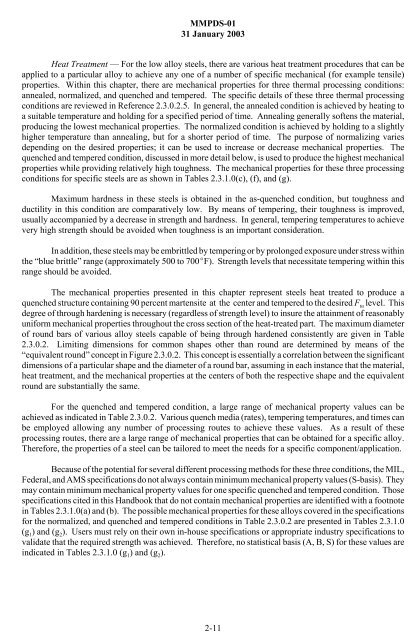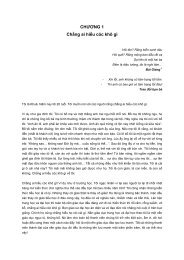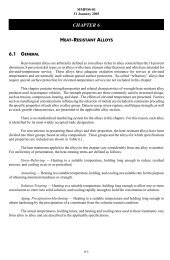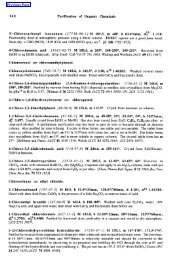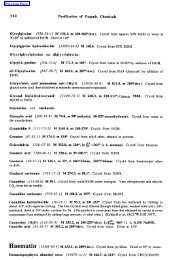steel - Nouvelle page 1 - Free
steel - Nouvelle page 1 - Free
steel - Nouvelle page 1 - Free
Create successful ePaper yourself
Turn your PDF publications into a flip-book with our unique Google optimized e-Paper software.
MMPDS-01<br />
31 January 2003<br />
Heat Treatment — For the low alloy <strong>steel</strong>s, there are various heat treatment procedures that can be<br />
applied to a particular alloy to achieve any one of a number of specific mechanical (for example tensile)<br />
properties. Within this chapter, there are mechanical properties for three thermal processing conditions:<br />
annealed, normalized, and quenched and tempered. The specific details of these three thermal processing<br />
conditions are reviewed in Reference 2.3.0.2.5. In general, the annealed condition is achieved by heating to<br />
a suitable temperature and holding for a specified period of time. Annealing generally softens the material,<br />
producing the lowest mechanical properties. The normalized condition is achieved by holding to a slightly<br />
higher temperature than annealing, but for a shorter period of time. The purpose of normalizing varies<br />
depending on the desired properties; it can be used to increase or decrease mechanical properties. The<br />
quenched and tempered condition, discussed in more detail below, is used to produce the highest mechanical<br />
properties while providing relatively high toughness. The mechanical properties for these three processing<br />
conditions for specific <strong>steel</strong>s are as shown in Tables 2.3.1.0(c), (f), and (g).<br />
Maximum hardness in these <strong>steel</strong>s is obtained in the as-quenched condition, but toughness and<br />
ductility in this condition are comparatively low. By means of tempering, their toughness is improved,<br />
usually accompanied by a decrease in strength and hardness. In general, tempering temperatures to achieve<br />
very high strength should be avoided when toughness is an important consideration.<br />
In addition, these <strong>steel</strong>s may be embrittled by tempering or by prolonged exposure under stress within<br />
the “blue brittle” range (approximately 500 to 700EF). Strength levels that necessitate tempering within this<br />
range should be avoided.<br />
The mechanical properties presented in this chapter represent <strong>steel</strong>s heat treated to produce a<br />
quenched structure containing 90 percent martensite at the center and tempered to the desired F tu level. This<br />
degree of through hardening is necessary (regardless of strength level) to insure the attainment of reasonably<br />
uniform mechanical properties throughout the cross section of the heat-treated part. The maximum diameter<br />
of round bars of various alloy <strong>steel</strong>s capable of being through hardened consistently are given in Table<br />
2.3.0.2. Limiting dimensions for common shapes other than round are determined by means of the<br />
“equivalent round” concept in Figure 2.3.0.2. This concept is essentially a correlation between the significant<br />
dimensions of a particular shape and the diameter of a round bar, assuming in each instance that the material,<br />
heat treatment, and the mechanical properties at the centers of both the respective shape and the equivalent<br />
round are substantially the same.<br />
For the quenched and tempered condition, a large range of mechanical property values can be<br />
achieved as indicated in Table 2.3.0.2. Various quench media (rates), tempering temperatures, and times can<br />
be employed allowing any number of processing routes to achieve these values. As a result of these<br />
processing routes, there are a large range of mechanical properties that can be obtained for a specific alloy.<br />
Therefore, the properties of a <strong>steel</strong> can be tailored to meet the needs for a specific component/application.<br />
Because of the potential for several different processing methods for these three conditions, the MIL,<br />
Federal, and AMS specifications do not always contain minimum mechanical property values (S-basis). They<br />
may contain minimum mechanical property values for one specific quenched and tempered condition. Those<br />
specifications cited in this Handbook that do not contain mechanical properties are identified with a footnote<br />
in Tables 2.3.1.0(a) and (b). The possible mechanical properties for these alloys covered in the specifications<br />
for the normalized, and quenched and tempered conditions in Table 2.3.0.2 are presented in Tables 2.3.1.0<br />
(g 1 ) and (g 2 ). Users must rely on their own in-house specifications or appropriate industry specifications to<br />
validate that the required strength was achieved. Therefore, no statistical basis (A, B, S) for these values are<br />
indicated in Tables 2.3.1.0 (g 1 ) and (g 2 ).<br />
2-11


